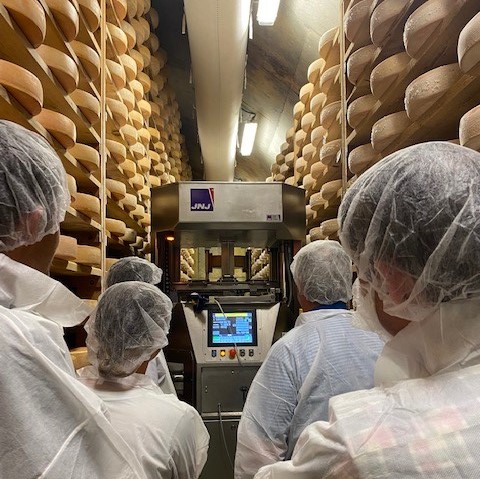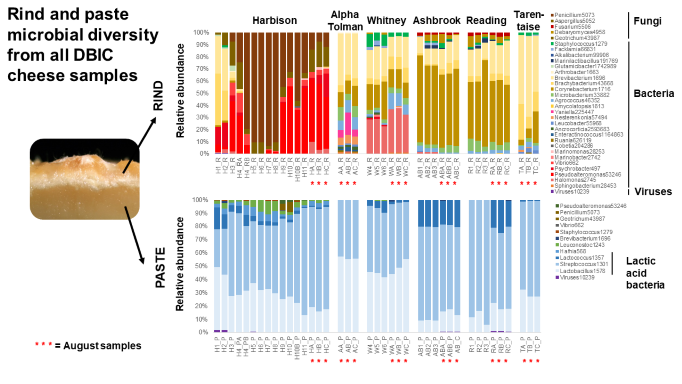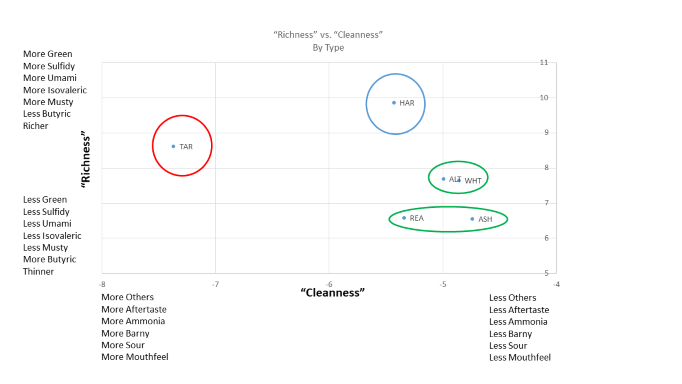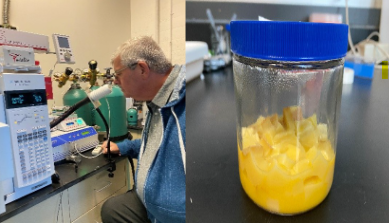
by Heather Darby and Roy Desrochers, University of Vermont Extension. This is the second installment on UVM Extension's Sensory Research. Read the first installment here.
“What’s a bug got to do with it?” might seem like a strange question, but it’s answer could increase the success of artisanal cheeses.
In 2020, The Vermont Agency of Agriculture, Northeast Dairy Business Innovation Center (NE-DBIC) teamed up with the University of Vermont Extension to investigate factors that influence artisanal cheese flavor quality. Recently, Dr. Ben Wolfe (microbiology) and Dr. Scott Frost (chemistry) from Tufts University collaborated with UVM Extension to understand the complex connection between flavor, microbes, and chemistry, in artisanal cheese.
In August, the multi-discipline team travelled to collaborating cheese farms, Jasper Hill and Spring Brook, to collect a set of cheese samples to submit to a range of analytical tests. It was critical to have the various tests conducted on the exact same set of cheese wheels so that the data could be linked.

preparing cheese samples for testing
The sample set included multiple wheels of Alpha Tolman, Whitney, and Harbison from Jasper Hill, and Reading, Ashbrook and Tarentaise from Spring Brook. The UVM Extension trained panel tasted the samples, while Tufts University conducted microbiological and innovative chemical tests on the same samples. The various data sets are currently being analyzed and initial results are promising.
The microbial diversity results begin to tell an interesting story.

Microbial diversity of 4 different cheeses from Jasper Hill and Spring Brook.
What microbes are present?
Microbial diversity was influenced by the type of cheese and by the type of cellar the cheese was aged in. The microbial diversity results suggest the cheese samples fall into four clusters, with Harbison being unique, Alpha Tolman and Whitney similar, Reading and Ashbrook similar, and Tarentaise being slightly different.
How do they impact the taste of the cheese?
The sensory data suggests a similar story. When plotting flavor dimensions that typically represent cheese flavor (“Richness”) and quality (“Cleanness”), we see a similar picture to the microbial diversity result with Harbison (HAR) and Tarentaise (TAR) occupying unique positions on the flavor map, Alpha Tolman (ALT) and Whitney (WHT) plotting closer, as with Reading (REA) and Ashbrook (ASH).

Sensory data of the 4 cheeses evaluated in the study.
What type of chemistry do they create?
In addition to microbial and sensory data, we generated a robust chemical/sensory database on the cheese samples using a Gas Chromatograph/Mass Spectrometer (GC/MS) that was outfitted with an Odor Detection Port (ODP). The ODP allows a trained smeller to describe the odors as the GC/MS identifies chemical peaks. The chemistry data is currently being compiled. An example chromatogram for Harbison identifies a range of flavor compounds. The sensory information generated by the trained smeller at the ODP will be added to the chemistry results. Once completed, it will help us understand the contribution of chemical compounds identified in cheese to its flavor. In addition, it will help us begin to link flavor chemistry and microbial diversity to cheese flavor.

The gas chromatograph/mass spectrometer and the trained smeller collecting cheese chemistry data

Chemical compounds identified from Harbison using the gas chromatopraph/mass spectrometer.
What’s a bug got to do with it?
Microbes generate the chemistry responsible for the cheese flavor we love. By understanding possible connections between microbes (bugs), chemistry, and flavor, we can help cheese makers engineer cheese in the future that optimizes customer satisfaction. Answering the question, “What’s a bug got to do with it?” is key to success.

